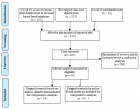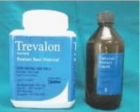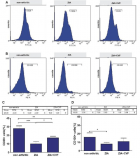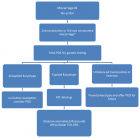Abstract
Review Article
Pre-eminence and comparative analysis of skin and surface disinfectants: A systematic review to pave the way for SARS-CoV-2 prevention
Bikash Medhi*, Anupam Raja, Saifuddin PK, Nishant Shekhar, Harvinder Singh, Phulen Sarma and Ajay Prakash
Published: 29 April, 2021 | Volume 5 - Issue 1 | Pages: 047-053
More than 200 countries have been devastated by the SARS-CoV-2 pandemic. The health workers exposed to SARS patients have been confirmed to be infected with coronavirus (SARS-CoV-2), regardless of the degree of their exposure. The increasing complexity of virus existence and heterogeneity has cast doubt on disinfectants as a viable choice. Hence, the present systematic review aims to achieve the comparative analysis of established disinfectants against enveloped and non-enveloped viruses including SARS-CoV and MERS-CoV. Three databases (Pubmed, Google scholar, and Medline) were searched to frame the systematic review. Our comparative analyses with 34 studies have found that 85% ethanol-based hand sanitizers and 7.5% Povidine Iodine based soaps/surgical scrub could be used to deter the SARS-CoV-2 virus as preferred hand sanitizers. For surface eradication, 0.5% sodium hypochlorite or a mixture of glutaraldehyde, Quaternary Ammonium Compounds (QAC), and isopropanol could have more efficacies as compared to hydrogen peroxide, phenol, and QAC alone. Moreover, the accelerated hydrogen peroxide as an active ingredient in the automatic quick surface disinfectant (tunnel system), maybe a positive indication for quick whole-body sanitation. Additionally, the alternative method for avoiding the rapidly increasing chain of infection with SARS and restarting regular life has been exclusively discussed.
Read Full Article HTML DOI: 10.29328/journal.ijcv.1001035 Cite this Article Read Full Article PDF
Keywords:
SARS-CoV-2; Quick body sanitation; Povidine iodine based soaps/surgical scrub; Tunnel system; Hand sanitizers and surface sanitizers
References
- A TP. The Classification of Viruses. Annu Rev Microbiol. 1996.
- Weissenhorn W, Dessen A, Calder LJ, Harrison SC, Skehel JJ, et al. Structural basis for membrane fusion by enveloped viruses. Mole Membr Biol. 1999; 16: 3-9. PubMed: https://pubmed.ncbi.nlm.nih.gov/10332732/
- Cromeans TL, Kahler AM, Hill VR. Inactivation of Adenoviruses, Enteroviruses, and Murine Norovirus in Water by Free Chlorine and Monochloramine. Appl Environ Microbiol. 2010; 76: 1028-1033. PubMed: https://pubmed.ncbi.nlm.nih.gov/20023080/
- Modes of action of disinfectants. 1995.
- Sharp DG, Leong J. Inactivation of poliovirus I (Brunhilde) single particles by chlorine in water. Appl Environ Microbiol. 1980; 40: 381–385. PubMed: https://pubmed.ncbi.nlm.nih.gov/6258476/
- Thurman RB, Gerba CP. Molecular Mechanisms of Viral Inactivation by Water Disinfectants. Adv Appl Microbiol. 1985; 75–105. https://linkinghub.elsevier.com/retrieve/pii/S0065216408702053
- Al-Qahtani AA. Severe Acute Respiratory Syndrome Coronavirus 2 (SARS-CoV-2): Emergence, history, basic and clinical aspects. Saudi J Biol Sci. 2020; 27: 2531–2538. PubMed: https://pubmed.ncbi.nlm.nih.gov/32336927/
- Chen X, Ran L, Liu Q, Hu Q, Du X, et al. Hand Hygiene, Mask-Wearing Behaviors and Its Associated Factors during the COVID-19 Epidemic: A Cross-Sectional Study among Primary School Students in Wuhan, China. Int J Environ Res Public Health. 2020; 17: 2893. PubMed: https://pubmed.ncbi.nlm.nih.gov/32331344/
- Walsh KA, Jordan K, Clyne B, Rohde D, Drummond L, et al. SARS-CoV-2 detection, viral load and infectivity over the course of an infection. J Infect. 2020; 81: 357–371. PubMed: https://www.ncbi.nlm.nih.gov/pmc/articles/PMC7323671/
- Steinmann J, Becker B, Bischoff B, Magulski T, Steinmann J, et al. Virucidal activity of Formulation I of the World Health Organization’s alcohol-based handrubs: Impact of changes in key ingredient levels and test parameters. Antimicrob Resist Infect Control. 2013; 2. PubMed: https://pubmed.ncbi.nlm.nih.gov/24330802/
- Rabenau HF, Kampf G, Cinatl J, Doerr HW. Efficacy of various disinfectants against SARS coronavirus. J Hospital Infect. 2005; 61: 107-111. PubMed: https://pubmed.ncbi.nlm.nih.gov/15923059/
- Eggers M, Koburger-Janssen T, Ward LS, Newby C, Müller S. Bactericidal and Virucidal Activity of Povidone-Iodine and Chlorhexidine Gluconate Cleansers in an In Vivo Hand Hygiene Clinical Simulation Study. Infect Dis Ther. 2018; 7: 235-247. PubMed: https://pubmed.ncbi.nlm.nih.gov/29761329/
- Eggers M, Eickmann M, Kowalski K, Zorn J, Reimer K. Povidone-iodine hand wash and hand rub products demonstrated excellent in vitro virucidal efficacy against Ebola virus and modified vaccinia virus Ankara, the new European test virus for enveloped viruses. BMC Infect Dis. 2015; 15: 375. PubMed: https://pubmed.ncbi.nlm.nih.gov/26381737/
- Ionidis G, Hübscher J, Jack T, Becker B, Bischoff B, et al. Development and virucidal activity of a novel alcohol-based hand disinfectant supplemented with urea and citric acid. BMC Infect Dis. 2016: 16: 77 PubMed: https://pubmed.ncbi.nlm.nih.gov/26864562/
- Sauerbrei A, Wutzler P. Virucidal efficacy of povidone-iodine-containing disinfectants: Virucidal efficacy of PVP-iodine. Lett Appl Microbiol. 2010.
- Tsai JC, Lin YK, Huang YJ, Loh EW, Wen HY, et al. Antiseptic Effect of Conventional Povidone–Iodine Scrub, Chlorhexidine Scrub, and Waterless Hand Rub in a Surgical Room: A Randomized Controlled Trial. Infect Control Hosp Epidemiol. 2017; 38: 417-422 PubMed: https://pubmed.ncbi.nlm.nih.gov/27995837/
- Hitosugi T, Tsukamoto M, Yokoyama T. Pneumonia due to aspiration of povidine iodine after preoperative disinfection of the oral cavity. Oral Maxillofac Surg. 2019; 23: 507-511. PubMed: https://pubmed.ncbi.nlm.nih.gov/31673818/
- Kawahara T, Akiba I, Sakou M, Sakaguchi T, Taniguchi H. Inactivation of human and avian influenza viruses by potassium oleate of natural soap component through exothermic interaction. In T. Webster (Ed.), PLoS ONE. 2018.
- Cords BR, Sanitizers DGR. Halogens, surface-active agents and peroxides: Antimicrobials in foods. PM and Branen, AL. Marcel Dekker Inc. 1993.
- McDonnell G, Russell AD. Antiseptics and disinfectants: Activity, action, and resistance. Clinical Microbiology Rev. 1999; 12: 147–179. PubMed: https://www.ncbi.nlm.nih.gov/pmc/articles/PMC88911/
- Omidbakhsh N, Sattar SA. Broad-spectrum microbicidal activity, toxicologic assessment, and materials compatibility of a new generation of accelerated hydrogen peroxide-based environmental surface disinfectant. Am J Infect Control. 2006; 34: 251–257. PubMed: https://pubmed.ncbi.nlm.nih.gov/16765201/
- Sattar SA, Springthorpe VS. Survival and disinfectant inactivation of the human immunodeficiency virus: A critical review. Reviews of Infectious Diseases. 1991.
- Bird CE, Criqui MH, Fronek A, Denenberg JO, Klauber MR, et al. Quantitative and qualitative progression of peripheral arterial disease by non-invasive testing. Vasc Med. 1999; 4: 15–21.
- Rutala WA, Weber DJ. 2004.
- Spaulding EH. Chemical disinfect of medical and surgical materials. Disinfection, sterilization and preservation. 1968.
- Weber DJ, Barbee SL, Sobsey MD, Rutala WA. The effect of blood on the antiviral activity of sodium hypochlorite, a phenolic, and a quaternary ammonium compound. Inf Control Hospital Epidemiol. 1999; 20: 821–827. PubMed: https://pubmed.ncbi.nlm.nih.gov/10614606/
- Jakobsson SW, Rajs J, Jonsson JA, Persson H. Poisoning with sodium hypochlorite solution. Report of a fatal case, supplemented with an experimental and clinico-epidemiological study. Am J Foren Med Pathol. 1991; 12: 320-327. PubMed: https://pubmed.ncbi.nlm.nih.gov/1807142/
- Merritt K, Hitchins VM, Brown SA. Safety and cleaning of medical materials and devices. Journal of Biomedical Materials Research: An Official Journal of The Society for Biomaterials, The Japanese Society for Biomaterials, and The Australian Society for Biomaterials and the Korean Society for Biomaterials. 2000; 53: 131–136.
- Dellanno C, Vega Q, Boesenberg D. The antiviral action of common household disinfectants and antiseptics against murine hepatitis virus, a potential surrogate for SARS coronavirus. Am J Infect Control. 2009; 37: 649–652. PubMed: https://pubmed.ncbi.nlm.nih.gov/19692148/
- Cavalli A, Marinaro M, Desario C, Corrente M, Camero M, et al. In vitro virucidal activity of sodium hypochlorite against canine parvovirus type 2. Epidemiol Infect. 2018; 146: 2010–2013. PubMed: https://pubmed.ncbi.nlm.nih.gov/30178730/
- Ehrenkranz NJ, Bolyard E, Wiener M, Cleary T. Antibiotic-sensitive Serratia marcescens infections complicating cardiopulmonary operations: Contaminated disinfectant as a reservoir. Lancet. 1980; 316; 1289–1292.
- Sehulster LM. Healthcare laundry and textiles in the United States: Review and commentary on contemporary infection prevention issues. Infect Control Hospital Epidemiol. 2020.
- Shickman MD, Guze LB, Pearce ML, Yamashita J. Bacteremia following cardiac catheterization: Report of a case and studies on the source. New Engl J Med. 1959; 260: 1164–1166.
- Shere L. Some comparisons of the disinfecting properties of hypochlorites and quaternary ammonium compounds. Milk Plant Monthly. 1948; 37: 66–69.
- D’Souza DH, Su X. Efficacy of chemical treatments against murine norovirus, feline calicivirus, and MS2 bacteriophage. Foodborne Pathogens is. 2010; 7: 319–326. PubMed: https://pubmed.ncbi.nlm.nih.gov/19919284/
- Belliot G, Lavaux A, Souihel D, Agnello D, Pothier P. Use of murine norovirus as a surrogate to evaluate resistance of human norovirus to disinfectants. Appl Environ Microbiol. 2008; 74: 3315–3318. PubMed: https://pubmed.ncbi.nlm.nih.gov/18378650/
- Whitehead K, McCue KA. Virucidal efficacy of disinfectant actives against feline calicivirus, a surrogate for norovirus, in a short contact time. Am J Infect Control. 2010; 38: 26–30. PubMed: https://pubmed.ncbi.nlm.nih.gov/19616346/
- Zonta W, Mauroy A, Farnir F, Thiry E. Comparative virucidal efficacy of seven disinfectants against murine norovirus and feline calicivirus, surrogates of human norovirus. Food Environ Virol. 2016; 8: 1-12. PubMed: https://pubmed.ncbi.nlm.nih.gov/26445948/
- Washington State Retail Food Code. (n.d.). 144.
- COVID-19 Information for Food Safety | Washington State Department of Agriculture. (n.d.). 2021. PubMed: https://agr.wa.gov/departments/food-safety/food-safety/covid-19-information-for-food-safety
- Coronavirus and Food Safety | FAQs | The Food Safety Authority of Ireland. (n.d.). 2021. https://www.fsai.ie/faq/coronavirus.html
- Guidelines for Environmental Infection Control in Health-Care Facilities: (545922006-001). Am Psychol Assoc. 2003.
- Century 21—Pregnant with Ozone: Ozone. (n.d.). Sci Engin. 24. https://www.tandfonline.com/doi/abs/10.1080/01919510208901590
- Cai J, Sun W, Huang J, Gamber M, Wu J, et al. Indirect Virus Transmission in Cluster of COVID-19 Cases, , Wenzhou, China, 2020. 2020; 26: 1343-1345. PubMed: https://pubmed.ncbi.nlm.nih.gov/32163030/
- Szeto W, Yam WC, Huang H, Leung DYC. The efficacy of vacuum-ultraviolet light disinfection of some common environmental pathogens. PubMed: https://www.ncbi.nlm.nih.gov/pmc/articles/PMC7014767/
- Siddharta A, Pfaender S, Vielle NJ, Dijkman R, Friesland M, et al. Virucidal Activity of World Health Organization–Recommended Formulations Against Enveloped Viruses, Including Zika, Ebola, and Emerging Coronaviruses. J Infect Dis. 2017; 215: 902-906. PubMed: https://pubmed.ncbi.nlm.nih.gov/28453839/
- Biermann NM, McClure JT, Sanchez J, Saab M, Doyle AJ. Prospective, randomised clinical trial of four different presurgical hand antiseptic techniques in equine surgery. Equine Vet J. 2019; 51: 600-605. PubMed: https://pubmed.ncbi.nlm.nih.gov/30565715/
- Deshpande A, Fox J, Wong KK, Cadnum JL, Sankar T, et al. Comparative Antimicrobial Efficacy of Two Hand Sanitizers in Intensive Care Units Common Areas: A Randomized, Controlled Trial. Infect Control Hosp Epidemiol. 2018; 39: 267-271. PubMed: https://pubmed.ncbi.nlm.nih.gov/29382400/
Figures:

Figure 1
Similar Articles
-
Hypothesis about pathogenic action of Sars-COV-2Del Prete Salvatore*,Marasco Daniela,Sabetta Rosalaura. Hypothesis about pathogenic action of Sars-COV-2. . 2020 doi: 10.29328/journal.ijcv.1001009; 4: 021-022
-
Exploring pathophysiology of COVID-19 infection: Faux espoir and dormant therapeutic optionsVinod Nikhra*. Exploring pathophysiology of COVID-19 infection: Faux espoir and dormant therapeutic options. . 2020 doi: 10.29328/journal.ijcv.1001013; 4: 034-040
-
Identifying patterns in COVID-19: Morbidity, recovery and the aftermathVinod Nikhra*. Identifying patterns in COVID-19: Morbidity, recovery and the aftermath. . 2020 doi: 10.29328/journal.ijcv.1001016; 4: 056-064
-
Role of nanotechnology in diagnosing and treating COVID-19 during the PandemicAbdul Baset*,Abdul Waris,Muhammad Ali,Atta Ullah Khan,Asmat Ali. Role of nanotechnology in diagnosing and treating COVID-19 during the Pandemic. . 2020 doi: 10.29328/journal.ijcv.1001017; 4: 065-070
-
Can house flies mechanically carry and/or transport sars-cov-2?Alfredo Montes*,Wilfrido Coronell,Rosa Baldiris. Can house flies mechanically carry and/or transport sars-cov-2?. . 2020 doi: 10.29328/journal.ijcv.1001019; 4: 076-078
-
Inhaled statins to combat COVID-19 – prophylactic and treatment approachArchana P Iyer*,Maryam A Al-Ghamdi. Inhaled statins to combat COVID-19 – prophylactic and treatment approach. . 2020 doi: 10.29328/journal.ijcv.1001020; 4: 079-080
-
A Comprehensive review on genomic diversity and epidemiology of COVID-19Zeshan Haider Raza*,Muhammad Ahmed Ihsan,Sahrish Khan,Haroon Zafar,Tayyaba Rehman. A Comprehensive review on genomic diversity and epidemiology of COVID-19. . 2020 doi: 10.29328/journal.ijcv.1001021; 4: 081-095
-
The expected second wave of COVID-19Madiha Asghar*,Misbahud Din. The expected second wave of COVID-19. . 2020 doi: 10.29328/journal.ijcv.1001024; 4: 109-110
-
COVID-19 pandemic, recurrent outbreaks and prospects for assimilation of hCoV-19 into the human genomeVinod Nikhra*. COVID-19 pandemic, recurrent outbreaks and prospects for assimilation of hCoV-19 into the human genome. . 2020 doi: 10.29328/journal.ijcv.1001025; 4: 111-115
-
Stages in COVID-19 vaccine development: The Nemesis, the Hubris and the ElpisVinod Nikhra*. Stages in COVID-19 vaccine development: The Nemesis, the Hubris and the Elpis. . 2020 doi: 10.29328/journal.ijcv.1001028; 4: 126-135
Recently Viewed
-
Endometriosis as a risk factor for colorectal cancerVíctor Manuel Vargas-Hernández*,José María Tovar- Rodríguez,Víctor Manuel Vargas-Aguilar . Endometriosis as a risk factor for colorectal cancer. Clin J Obstet Gynecol. 2020: doi: 10.29328/journal.cjog.1001057; 3: 093-097
-
Adult Neurogenesis: A Review of Current Perspectives and Implications for Neuroscience ResearchAlex, Gideon S*,Olanrewaju Oluwaseun Oke,Joy Wilberforce Ekokojde,Tolulope Judah Gbayisomore,Martina C. Anene-Ogbe,Farounbi Glory,Joshua Ayodele Yusuf. Adult Neurogenesis: A Review of Current Perspectives and Implications for Neuroscience Research. J Neurosci Neurol Disord. 2024: doi: 10.29328/journal.jnnd.1001102; 8: 106-114
-
Analysis of Psychological and Physiological Responses to Snoezelen Multisensory StimulationLucia Ludvigh Cintulova,Jerzy Rottermund,Zuzana Budayova. Analysis of Psychological and Physiological Responses to Snoezelen Multisensory Stimulation. J Neurosci Neurol Disord. 2024: doi: 10.29328/journal.jnnd.1001103; 8: 115-125
-
Sexual Dimorphism in the Length of the Corpus Callosum in CadaverShahnaj Pervin*,Nasaruddin A,Irfan M,Annamalai L. Sexual Dimorphism in the Length of the Corpus Callosum in Cadaver. J Neurosci Neurol Disord. 2024: doi: 10.29328/journal.jnnd.1001104; 8: 126-129
-
Improvement of the Cognitive Abilities in a Chronic Generalized Anxiety Disorder and Moderate Depression Case using a Novel Integrated Approach: The Cognitome ProgramMohita Shrivastava*. Improvement of the Cognitive Abilities in a Chronic Generalized Anxiety Disorder and Moderate Depression Case using a Novel Integrated Approach: The Cognitome Program. J Neurosci Neurol Disord. 2024: doi: 10.29328/journal.jnnd.1001100; 8: 069-089
Most Viewed
-
Evaluation of Biostimulants Based on Recovered Protein Hydrolysates from Animal By-products as Plant Growth EnhancersH Pérez-Aguilar*, M Lacruz-Asaro, F Arán-Ais. Evaluation of Biostimulants Based on Recovered Protein Hydrolysates from Animal By-products as Plant Growth Enhancers. J Plant Sci Phytopathol. 2023 doi: 10.29328/journal.jpsp.1001104; 7: 042-047
-
Sinonasal Myxoma Extending into the Orbit in a 4-Year Old: A Case PresentationJulian A Purrinos*, Ramzi Younis. Sinonasal Myxoma Extending into the Orbit in a 4-Year Old: A Case Presentation. Arch Case Rep. 2024 doi: 10.29328/journal.acr.1001099; 8: 075-077
-
Feasibility study of magnetic sensing for detecting single-neuron action potentialsDenis Tonini,Kai Wu,Renata Saha,Jian-Ping Wang*. Feasibility study of magnetic sensing for detecting single-neuron action potentials. Ann Biomed Sci Eng. 2022 doi: 10.29328/journal.abse.1001018; 6: 019-029
-
Pediatric Dysgerminoma: Unveiling a Rare Ovarian TumorFaten Limaiem*, Khalil Saffar, Ahmed Halouani. Pediatric Dysgerminoma: Unveiling a Rare Ovarian Tumor. Arch Case Rep. 2024 doi: 10.29328/journal.acr.1001087; 8: 010-013
-
Physical activity can change the physiological and psychological circumstances during COVID-19 pandemic: A narrative reviewKhashayar Maroufi*. Physical activity can change the physiological and psychological circumstances during COVID-19 pandemic: A narrative review. J Sports Med Ther. 2021 doi: 10.29328/journal.jsmt.1001051; 6: 001-007

HSPI: We're glad you're here. Please click "create a new Query" if you are a new visitor to our website and need further information from us.
If you are already a member of our network and need to keep track of any developments regarding a question you have already submitted, click "take me to my Query."

















































































































































